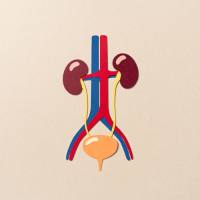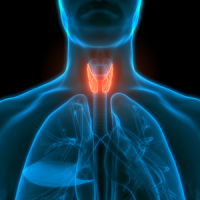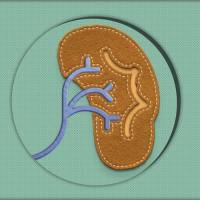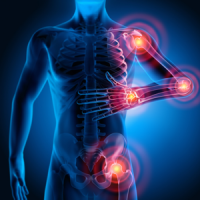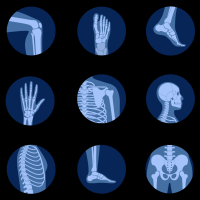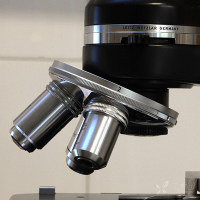《Neuron》:ACAT抑制剂减少阿兹海默症小鼠病变
ACAT抑制剂单用或与他汀类药联用“可能有效地预防和治疗阿兹海默症”,美国波士顿MassGeneral神经变性性疾病研究所的科瓦克斯(Dora M. Kovacs)告诉路透社记者。他和同事以前曾发现,ACAT影响了阿兹海默症病人脂斑中淀粉样β肽的生成,并在细胞研究中证实ACAT抑制剂CP-113,818抑制了淀粉样β肽的生成。
在这个发表于《神经元》杂志(Neuron 2004;44:227-238)的新研究中,这些科学家又证明了CP-113,818减少了转基因小鼠(表达有人类淀粉样前驱蛋白)大脑中的淀粉样病变。用CP-113,818治疗2个月,大脑胆固醇酯减少86%,淀粉样β肽减少83-96%,淀粉样脂斑的积聚减少88-99%。CP-113,818治疗还导致空间学习力的轻度改善,这些改善与淀粉样β肽的减少有关。“胆固醇高是心血管疾病和阿兹海默症共同的风险因素”,科瓦克斯说,“而ACAT抑制剂可能治疗这两种疾病”。
尽管ACAT抑制剂CP-113,818现在还没在临床试验中检测,但另一种ACAT抑制剂avasimibe(辉瑞公司)已在III期试验中用来治疗血管疾病和动脉硬化了。ACAT抑制剂与他汀类联用也值得研究,因为研究表明他汀类对阿兹海默症的预防和治疗都有用。
Article
The ACAT Inhibitor CP-113,818 Markedly Reduces Amyloid Pathology in a Mouse Model of Alzheimer's Disease
Birgit Hutter-Paier1, 7, Henri J. Huttunen2, 3, 4, 7, Luigi Puglielli2, 3, 4, 8, Christopher B. Eckman6, Doo Yeon Kim2, 3, 4, Alexander Hofmeister1, Robert D. Moir3, 4, Sarah B. Domnitz4, 5, Matthew P. Frosch4, 5, Manfred Windisch1 and Dora M. Kovacs, 2, 3, 4, ,
1 JSW-Research Forschungslabor GmbH, Institute of Experimental Pharmacology, Rankengasse 28, 8020, Graz, Austria
2 Neurobiology of Disease Laboratory, Harvard Medical School, 114 16th Street, Charlestown, MA 02129, USA
3 Genetics and Aging Research Unit, Harvard Medical School, 114 16th Street, Charlestown, MA 02129, USA
4 Department of Neurology/MassGeneral Institute for Neurodegenerative Disease, Harvard Medical School, 114 16th Street, Charlestown, MA 02129, USA
5 Department of Pathology, Massachusetts General Hospital, Harvard Medical School, 114 16th Street, Charlestown, MA 02129, USA
6 Department of Neuroscience, Mayo Clinic, Jacksonville, 4500 San Pablo Road, Jacksonville, FL 32224, USA
Received 19 February 2004; Revised 28 July 2004; accepted 17 August 2004 Published: October 13, 2004 Available online 13 October 2004.
Abstract
Amyloid -peptide (A) accumulation in specific brain regions is a pathological hallmark of Alzheimer's disease (AD). We have previously reported that a well-characterized acyl-coenzyme A: cholesterol acyltransferase (ACAT) inhibitor, CP-113,818, inhibits A production in cell-based experiments. Here, we assessed the efficacy of CP-113,818 in reducing AD-like pathology in the brains of transgenic mice expressing human APP751 containing the London (V717I) and Swedish (K670M/N671L) mutations. Two months of treatment with CP-113,818 reduced the accumulation of amyloid plaques by 88%–99% and membrane/insoluble A levels by 83%–96%, while also decreasing brain cholesteryl-esters by 86%. Additionally, soluble A42 was reduced by 34% in brain homogenates. Spatial learning was slightly improved and correlated with decreased A levels. In nontransgenic littermates, CP-113,818 also reduced ectodomain shedding of endogenous APP in the brain. Our results suggest that ACAT inhibition may be effective in the prevention and treatment of AD by inhibiting generation of the A peptide.
Article Outline
• Introduction
• Results
• Discussion
• Experimental Procedures
• Animals and Drug Treatment
• Tissue Sampling
• Cholesterol Determinations
• Brain Plaque Load and Synaptophysin Analyses
• A1-40 and A1-42 Determinations
• Behavior
• Western Blot Analysis
• In Vitro Fluorometric BACE1 Activity Assay
• In Vitro Generation of APP Intracellular Domain
• Turbidity Assay
• Acknowledgements
• References
Introduction
Alzheimer's disease (AD) is a neurodegenerative disorder that is characterized by progressive cognitive impairment, personality changes, and specific neuropathological abnormalities. Senile (or amyloid) plaques, extensive neuronal loss, and neurofibrillary tangles represent the main histological hallmarks observed in AD brains. Amyloid -peptide (A) aggregates form the core of senile plaques and are increased in all forms of the disease (Glenner and Wong, 1984). A consistent feature of familial AD mutations causing early-onset forms of the disease is an overproduction of A peptides or of the more pathogenic A42 in specific regions of the brain (Selkoe, 1999). A is a 39–43 amino acid hydrophobic polypeptide that is derived from a large precursor, the amyloid precursor protein (APP) (Kang et al. 1987 and Tanzi et al. 1987). The enzymes that generate A have been identified and partially characterized. At the N terminus of A, APP is cleaved by -secretase or -site APP-cleaving enzyme 1 (BACE1), while at the C terminus it is cleaved by a multisubunit aspartyl protease complex called -secretase (Aguzzi and Haass 2003; Citron 2004; De Strooper 2003; Sinha et al. 1999; Vassar 2004 and Xia and Wolfe 2003). Alternatively, -secretase cleaves in the middle of the A region of APP, preventing A generation (Ling et al., 2003). Following - and -secretase cleavages, A is released from the membrane and can then be degraded, bind specific proteins like 2-macroglobulin and ApoE, or aggregate into -pleated fibrillar oligomers (Ling et al., 2003).
Studies of both animal and cellular models of AD have shown that cholesterol homeostasis and distribution regulate A generation. Genetic and epidemiological data support a role for altered cholesterol metabolism in the pathogenesis of AD (Burns and Duff 2002; Hartmann 2001 and Puglielli et al. 2003). Statins, which inhibit cholesterol generation and internalization and thereby lower total cholesterol in cells, reduce A production in cells and in most animal models of AD (Petanceska et al., 2002). Retrospective and prospective clinical studies suggest that statins may lower the risk of developing AD, but large clinical trials are ongoing (Wolozin, 2004). It remains to be shown that statins can provide significant cognitive benefits for AD patients with normal serum cholesterol.
Multiple pathways are involved in regulation of cellular cholesterol distribution. One of these pathways is mediated by acyl-coenzyme A: cholesterol acyltransferase (ACAT), an endoplasmic reticulum resident enzyme. ACAT regulates intracellular cholesterol homeostasis by converting membrane cholesterol into cytoplasmic cholesteryl-ester droplets for storage, until free cholesterol and fatty acids are needed for normal membrane and cellular functions (Chang et al., 2001). ACAT inhibition has long been studied as a potential antiatherosclerotic strategy resulting in both reduced intestinal cholesterol absorption and foam cell formation (Shah, 2003). We have previously presented genetic, metabolic, and pharmacological evidence that inhibition of ACAT activity results in reduced A generation in cell-based models of AD and in primary neurons (Puglielli et al., 2001). In particular, we showed that two ACAT inhibitors, CP-113,818 and Dup128, inhibited A production by up to 50%.
Here, we used the ACAT inhibitor CP-113,818 in a transgenic mouse model of AD to assess whether ACAT is a potential target for antiamyloid therapy in patients affected by AD.
Results
CP-113,818 is a fatty acid anilide derivative designed to mimic the acyl-CoA substrate of ACAT and a potent ACAT inhibitor in vitro, cell culture, and animals (Chang et al. 2000; Marzetta et al. 1994 and Puglielli et al. 2001). In order to determine the in vivo efficacy of CP-113,818 in reducing mouse brain cholesteryl-ester levels, we initially treated nontransgenic animals with the ACAT inhibitor. Most ACAT inhibitors are poorly absorbed when administered orally and are quickly turned over in the blood or tissues (Marzetta et al., 1994). To minimize daily fluctuations in serum CP-113,818 levels in mice, we delivered the inhibitor via implantable slow-release biopolymer pellets. Pellets containing CP-113,818 were inserted surgically under dorsal skin to allow for continuous and controlled release of the active compound over an established period of time with effectively zero-order kinetics (Innovative Research of America). Eighteen nontransgenic mice at 3 months of age received 21 day-release biopolymer pellets containing 0, 0.2, 1.6, 3.2, 4.8, and 7.1 mg/kg/day of CP-113,818 (n = 3 per dose; Figure 1A). The highest dose that was used in these studies was far below the tolerated dose of 150 mg/kg/day for rats, even allowing for relatively low bioavailability in these animals (Marzetta et al., 1994). CP-113,818 (7.1 mg/kg/day) reduced total cholesterol levels by 29% (p < 0.007) in the serum, in the absence of any evident effect on food consumption and body weight ( Figure 1A; data not shown). Hepatic free cholesterol and cholesteryl-esters were also decreased in a dose-dependent manner by up to 37% (p < 0.03) and 93% (p < 0.0004), respectively (Figure 1A). As expected, CP-113,818 had no effect on free cholesterol levels in the brain, since free cholesterol is largely immobilized in myelin membranes and is not likely perturbed by ACAT activity. Initial levels of cholesteryl-esters, 2.2 mg/g of brain tissue, were similar to reported values of approximately 3.5 mg/g of rat hippocampal tissue (Champagne et al., 2003) and corresponded to ~8% of total brain cholesterol. We found that free cholesterol:cholesteryl-ester ratios in mouse brains were approximately 10:1 but were only 3:1 in enriched neuronal primary cultures largely devoid of myelin (Supplemental Figure S1 at http://www.neuron.org/cgi/content/full/44/2/227/DC1). CP-113,818 (7.1 mg/kg) decreased cholesteryl-ester levels in mouse brains by 86% (p < 0.0004; Figure 1A). Thus, these data indicate that 7.1 mg/kg/day of CP-113,818 is effective in markedly reducing cholesteryl-ester levels in the brains of nontransgenic mice.
(47K)
Figure 1. CP-113,818 Reduces Cholesteryl-Ester Levels in Mouse Brains without Inducing Adrenal Toxicity(A) Concentration-dependent inhibition of ACAT activity in nontransgenic mice treated for 21 days with CP-113,818. The ACAT inhibitor was most effective at 7.1 mg/kg/day, reducing total cholesterol in the serum by 29% and cholesteryl-ester levels in the brain and liver by 86% and 93%, respectively, when compared to placebo-treated animals. Free or membrane cholesterol was decreased by up to 37% in the liver. Data represent mean ± SD, N = 3 (Student's two-tailed t test; *p < 0.05, **p < 0.01, ***p < 0.001).(B) hAPP mice treated with 7.2 mg/kg/day of CP-113,818 for 2 months did not show signs of vacuolization in the cytoplasm of adrenal cortical cells (lower panels), which would represent a first indication of toxicity derived from most ACAT inhibitors.(C) Decreased levels of serum (35%, p < 0.0003) and liver cholesterol (34%, p < 0.00009) and liver cholesteryl-esters (87%, p < 0.00001) in hAPP mice treated with 7.2 mg/kg/day of CP-113,818 for 2 months (57 days; N = 6 per treatment). These determinations were made on the same animals that were also used for brain amyloid and behavior studies. Data represent mean ± SD; N = 6 (Student's two-tailed t test; ***p < 0.001).
To characterize the effect of CP-113,818 treatment on AD-like pathology, we used hAPP mice that express human APP751 containing the London (V717I) and Swedish (K670M/N671L) mutations under the regulatory control of the murine Thy-1 promoter (mThy1-hAPP751) (Rockenstein et al., 2001). These animals develop detectable plaques in the neocortex and hippocampus at the ages of 4 and 6 months, respectively, and show memory deficits starting at 6 months of age. Given our prior observations that CP-113,818 reduced A generation and not clearance, we used relatively young hAPP mice to minimize initial A deposition. hAPP mice (n = 12) at 4.5 months of age were administered 60 day-release biopolymer pellets containing 13 mg of CP-113,818 (7.2 mg/kg/day), while age-matched animals were implanted with placebo pellets (n = 12). Recent reports have shown that female mice have higher levels of A and amyloid pathology than age-matched males in a variety of AD transgenic mouse models (Callahan et al. 2001; Lee et al. 2002 and Wang et al. 2003) and that lovastatin may function in a gender-specific manner (Park et al., 2003). Therefore, we included similar numbers of male and female animals in both placebo and CP-113,818 groups to detect possible gender-specific effects of the inhibitor in our mouse model. Following 4 days of Morris water maze (MWM) tests, the animals were sacrificed at day 57 to ensure continued presence of the inhibitor. At 7.2 mg/kg/day of CP-113,818, there was no histologic evidence of toxicity found in adrenal cortical cells, a potential class-related effect of ACAT inhibitors (Figure 1B). Serum total cholesterol and liver free cholesterol/cholesteryl-esters were reduced to levels similar to those previously observed in nontransgenic animals (Figures 1A and 1C). It is noteworthy that liver cholesteryl-ester levels decreased by 87% (p < 0.0001) in hAPP mice treated for 2 months with CP-113,818 (Figure 1C). Taken together, these experiments demonstrated that 2 months of CP-113,818 treatment effectively reduced cholesteryl-ester levels of hAPP mice in the absence of adrenal toxicity. The tissue requirements for assessment of A burden in the brains of these animals precluded direct examination of their brain cholesteryl-ester levels.
Brain plaque load was evaluated by thioflavin S and immunohistochemical stainings (Figure 2). Thioflavin S-positive plaques were barely detectable in the cortex of hAPP mice at 6.5 months of age and absent in CP-113,818-treated animals (Figure 2A). However, A staining with the monoclonal antibody 6E10 revealed abundant A deposits in placebo-treated mouse brains (Figures 2A and 2B). Individual differences in amyloid load reflected the well-known variability in A accumulation that has been previously observed in transgenic mice, specifically at early stages of pathology (Johnson-Wood et al. 1997 and Kawarabayashi et al. 2001). Amyloid load in the cortex of female animals was 2-fold higher than that in males, in agreement with previous studies in other mouse models of AD (Callahan et al. 2001; Lee et al. 2002 and Wang et al. 2003). The hippocampus, slower than the cortex in developing amyloid pathology in hAPP mice, contained significant numbers of A deposits only in female but not in male animals ( Figure 2B and Supplemental Figure S2 at http://www.neuron.org/cgi/content/full/44/2/227/DC1). In the cortices of all animals tested, CP-113,818 treatment reduced plaque numbers by 88% (p < 0.0000016). Importantly, when the two genders were considered separately, plaque numbers were reduced to an equal extent in females and males, by 89% (p < 0.00002) and 88% (p < 0.0002), respectively (Figure 2B). Thus, CP-113,818 treatment decreased amyloid load in a gender-independent manner. Plaque burden, as indicated by the percent of cortex covered by plaques, was also markedly decreased in all animals (by 90%, p < 0.000012). In females, the decrease was from 0.45 to 0.04 percent plaque load (p < 0.00002), while in males it was from 0.10 to 0.02 (p < 0.00013; Supplemental Figure S2B). As mentioned above, amyloid load in the hippocampus of male animals was too low at this age for reliable assessment of changes caused by CP-113,818. However, the most dramatic effects of the ACAT inhibitor were observed in the hippocampus of female mice, where plaque number decreased by 99% (p < 0.000001) and plaque coverage by 97% (p < 0.000001) from 0.295 to 0.09 percent plaque load ( Figure 2B and Supplemental Figure S2B). Plaque numbers in the cortex of female animals were similar at the beginning and the end of CP-113,818 treatment (Figure 2A), suggesting that the ACAT inhibitor prevents accumulation of newly formed plaques. Overall, these data show that CP-113,818 treatment was highly effective in reducing accumulation of amyloid plaques in hAPP mice and that this effect was gender independent.
(47K)
Figure 2. CP-113,818 Treatment for 57 Days Markedly Reduces Amyloid Load in the Brains of hAPP Transgenic Mice(A) Representative amyloid staining (using thioflavin S) and A staining (using the antibody 6E10) of female hAPP mouse cortices at 6.5 months of age following placebo and CP-113,818 treatments. A staining of cortices at day 0 (at 4 months of age) without and, at day 57, with CP-113,818 treatment was remarkably similar, suggesting that the ACAT inhibitor prevented formation of amyloid pathology in these mice.(B) Quantitative analysis of brain plaque load, as assessed by number of plaques per m2 stained with the A-specific antibody 6E10. In the hAPP animal model, the cortex is the first to develop amyloid pathology, followed by the hippocampus. Therefore, at 6.5 months of age, males exhibit distinct AD pathology in the cortex but not in the hippocampus. CP-113,818 reduced cortical plaque number by ~88%, equally in females (89%) and males (88%). The most marked effect was observed in the hippocampus of female mice, where amyloid load was decreased by 99%; p < 0.000001.
We next used a sandwich enzyme-linked immunosorbent assay (ELISA) to measure A1-40 and A1-42 levels in 70% formic acid extracts from brain homogenates ("insoluble" A) and in the initial Tris-buffered saline (TBS) fraction of the same homogenates (soluble A). Similar to plaque load, A levels varied widely, as expected in transgenic mice specifically at early stages of pathology (Johnson-Wood et al. 1997 and Kawarabayashi et al. 2001). Treatment with CP-113,818 decreased A1-40 and A1-42 in the formic acid fraction to almost undetectable concentrations. An overall 92% (p < 0.024) decrease in "insoluble" A1-40 as well as 83% (p < 0.032) in "insoluble" A1-42 was detected in all animals after treatment with CP-113,818, with no significant difference in the A1-42/A1-40 ratio (Figure 3A). Since brain extracts were obtained from entire hemispheres including cortices and hippocampi, the difference between male and female A levels at this age was accentuated by the slowly developing amyloid pathology in male hippocampi (see Figure 2B). When analyzed according to gender, only female "insoluble" A was sufficiently elevated to obtain a highly significant decrease by CP-113,818 treatment, with A1-40 down by 96% (p < 0.014) and A1-42 down by 90% (p < 0.014; Figure 3A). Importantly, soluble A levels were also decreased in the initial TBS fraction, with A1-42 showing a significant 34% reduction (p < 0.0014). This decrease was statistically significant in both genders. Soluble A1−40 levels were close to the limit of detection, but a trend toward decrease was observed (20%) in all animals, significant only in males (Figure 3B). Thus, three different methods of detection, thioflavin S and A stainings and A ELISAs, independently showed that CP-113,818 treatment is highly effective in reducing amyloid pathology in hAPP mice. The decrease in soluble A suggests that CP-113,818 may either reduce A generation or accelerate its catabolism or clearance.
(20K)
Figure 3. CP-113,818 Treatment Reduces Levels of "Insoluble" and Soluble A1-40 and A1-42 in the Brains of hAPP Transgenic Mice(A) Sandwich ELISAs of "insoluble" A1-40 and A1-42 in brain formic acid extracts revealed a significant decrease of both peptides in CP-113,818-treated animals (92% and 83%, respectively). The significance was higher in females than in males, due to lower starting A levels in brain extracts of placebo-treated males.(B) Sandwich ELISAs of soluble A1-40 and A1-42 in TBS fractions lacking detergents revealed a decrease of both peptides in CP-113,818-treated animals (12% and 34%, respectively), which was significant for A1-42. A1-40 levels were close to the baseline of the assay. A decrease was observed in both male and female animals.
To analyze the effect of CP-113,818 treatment on cognitive function of hAPP mice, we performed MWM spatial learning and memory tests on the animals. Since hAPP mice develop cognitive deficits starting at 6 months of age, the 6.5-month-old animals in our study were only expected to show slight deterioration due to A accumulation, when compared to nontransgenic littermates. Consistently, length of swimming path and time latency required for finding the submerged platform revealed only a slight disturbance in spatial learning and memory in transgenic animals, compared to their littermates. Clear impairment of cognitive function due to A accumulation was only observed in female transgenic mice. In these animals, CP-113,818 treatment reversed the observed impairment in spatial learning (p < 0.014; Figure 4). Compared to placebo, CP-113,818 treatment resulted in a significant improvement of learning between day 1 and day 3 (p < 0.016). CP-113,818 treatment did not affect spatial performance of nontransgenic female mice, consistent with lack of A deposition in these animals. Only on day 4, CP-113,818-treated male nontransgenic animals performed better than the placebo-treated cohort regarding swimming path (p < 0.04; Supplemental Figure S3 at http://www.neuron.org/cgi/content/full/44/2/227/DC1) but not escape latency; however, the improvement between day 1 and day 3 or 4 was identical for both groups. All hAPP mice taken together showed a trend toward acquiring the task quickly and reaching a plateau of performance on day 3 when treated with CP-113,818 (p < 0.07; Figure 4). This could have been due to a ceiling effect owing to maximum swimming speed. Compared to placebo, the improvement between day 1 and day 3 due to CP-113,818 treatment was significant (p < 0.033). As expected, CP-113,818 did not induce significant changes in synaptic density as assessed by synaptophysin immunoreactivity, consistent with lack of differences between nontransgenic versus transgenic animals given their young age (Supplemental Figure S4). Although testing of more mice at an older age will be needed to further assess the effect of decreased amyloid pathology on spatial learning and memory, improved performance in a MWM test correlated well with the highly significant decrease of overall plaque load and A in CP-113,818-treated female animals.
(12K)
Figure 4. CP-113,818 Treatment Restores Normal Spatial Learning and Memory in Female hAPP Mice in a Morris Water Maze TestBehavioral performance assessing spatial navigation was evaluated for each animal three times per day for 4 days, between days 54 and 57 of treatment with CP-113,818. In each Morris water maze (MWM) trial, swimming path (length in meters required to reach the platform) and escape latency (seconds to reach the platform) were measured. The top two panels show data collected from all animals in our study, regardless of gender. In addition to hAPP transgenic mice, we also used equal numbers of nontransgenic littermates untreated and treated with CP-113,818 in this study. The results show only a slight impairment in MWM trials in transgenic mice when compared to nontransgenics, thus leaving little room for improvement due to reduced amyloid accumulation by CP-113,818. The lower panels show exclusively results obtained with female mice. Correlating with 2-fold increased amyloid load in the female relative to the male cohort, only female transgenic animals exhibited a significant decline in performance when compared to nontransgenic littermates. Treatment with CP-113,818 improved this performance in the female cohort (p < 0.014 on day 3), so that treated hAPP transgenic animals performed similarly to nontransgenics in both the swimming path and escape latency tests. Data represent mean ± SEM; N = 3 trials per animal per day; statistical differences were calculated with the Mann-Whitney U test.
Our previous cell-based studies have shown that ACAT inhibition reduces A generation and alters APP processing by all three secretases (Puglielli et al., 2001). To determine whether CP-113,818 treatment modified brain APP processing in hAPP mice, we initially resolved formic acid-extracted brain proteins by SDS-PAGE to detect APP and its proteolytic derivatives. Western blot analysis showed that formic acid-extracted full-length APP and APP C-terminal fragments (CTFs) C83 and C99 were unchanged by CP-113,818. However, levels of the secreted cleavage products of both - and -secretases (sAPP) were reduced by treatment with the ACAT inhibitor, albeit not nearly as dramatically as A (Supplemental Figure S5 at http://www.neuron.org/cgi/content/full/44/2/227/DC1). Inhibition of sAPP production in the absence of a change in CTFs was somewhat surprising and possibly an artifact caused by formic acid extraction. Because tissue from treated hAPP mice had been extracted with formic acid or fixed for histological studies, we looked at levels of APP-CTFs in total brain lysates from the nontransgenic littermates used in the MWM tests. Using nontransgenic animals for these experiments also afforded an assessment of the effects of CP-113,818 on endogenous APP processing. CP-113,818 reduced liver cholesterol/cholesteryl-esters and serum cholesterol of nontransgenic littermates similarly to the transgenic animals shown in Figure 1C (data not shown). Endogenous mouse APP-CTF levels in brain lysates from CP-113,818-treated animals decreased by 44% when compared to placebo-treated mice (n = 8; p < 0.005; values normalized to APP holoprotein levels; Figures 5A and 5B). We could not resolve C99 and C83 from these samples due to smearing in the low molecular weight range because of high protein load (Figure 5A). However, we were able to specifically detect secreted APP (sAPP), the N-terminal product of -secretase cleavage, in the soluble TBS fraction of the initial homogenate. sAPP showed a trend toward decreasing (3.4%; p < 0.14 = not significant) in CP-113,818-treated animals, while total sAPP, which also includes the -secretase product sAPP, was significantly reduced by 19.1% (p < 0.038; Figures 5A and 5B). A 36% decrease (p < 0.013) in the ratio between total sAPP and sAPP indicates that inhibition of -secretase in ACAT inhibitor-treated mice is not as pronounced as that of other ectodomain-shedding proteases (e.g., BACE). We next asked whether -secretase component levels and activity were affected by CP-113,818 in the nontransgenic brain lysates. We did not detect significant changes in levels of PS1 N- and C-terminal fragments, nicastrin, and pen-2 ( Figure 5C; 8 of 16 samples shown, as in all other figures). Nicastrin maturation was also unaffected by CP-113,818 treatment. To detect potential changes in - and -secretase-like activities for substrates other than APP, we tested two -secretase substrates, Notch and N-cadherin (De Strooper et al. 1999 and Marambaud et al. 2003). Both proteins are also known to undergo -secretase-like cleavages, mediated by TACE for Notch and a metalloprotease for N-cadherin (Brou et al. 2000 and Marambaud et al. 2003). Notch intracellular domain (NICD) represents the final -secretase cleavage product, and its levels are indicative of changes in both -secretase-like and -secretase activities for Notch. NICD levels were statistically unchanged by CP-113,818 treatment, when the protein was immunoprecipitated from nontransgenic mouse brain lysates (Figure 5C). Similarly, levels of N-cadherin-CTF1, the product of metalloprotease cleavage and a substrate for -secretase, were unaffected by the ACAT inhibitor (Figure 5C). These data indicate that processing of at least two -secretase substrates was not altered by CP-113,818 and that -secretase-like cleavages of these substrates were also unaffected. BACE protein levels were also unchanged in brain lysates of CP-113,818-treated animals (Figure 5D). One mechanism that would explain our data is that ACAT inhibition may result in an interaction between APP and an unknown protein, blocking access of the three secretases to APP instead of direct inhibition of each secretase. Expression of ApoE, an essential protein in both brain lipid metabolism and A deposition/clearance, was also unchanged by ACAT inhibition (Figure 5D). In an effort to exclude potential direct effects of CP-113,818 on - and -secretase cleavages of APP in the absence of changes in cholesterol metabolism, we performed in vitro - and -secretase assays employing purified recombinant BACE1 and membrane fractions isolated from Chinese hamster ovary (CHO) cells harboring endogenous -secretase, respectively. Both BACE1 and -secretase activities were unaffected by increasing amounts of CP-113,818 in the reaction mixture (Figures 5E and 5F). Finally, we tested whether CP-113,818 directly modulates in vitro aggregation of A40 promoted by zinc or A42 (Bush et al. 1994 and Jarrett et al. 1993). CP-113,818 failed to directly inhibit aggregation of A40 in vitro, when promoted by zinc (p < 0.56) or A42 (p < 0.96) (Figure 5G). In the absence of zinc or A42, A40 alone did not significantly aggregate over 4 days (p < 0.671). Together, these data show that APP-CTFs, total sAPP, and, to a lesser extent, sAPP levels are decreased in the brains of CP-113,818-treated nontransgenic mice in the absence of any apparent change in the levels or processing of all control proteins tested. Although these data, together with decreased soluble A in hAPP mice, argue strongly that the ACAT inhibitor reduces A generation, they do not exclude additional beneficial effects of altered cholesterol metabolism on A aggregation, catabolism, and/or clearance.
(54K)
Figure 5. CP-113,818 Treatment of Nontransgenic Littermates Reduces Processing of Endogenous APP but Not Notch or N-Cadherin, without Directly Inhibiting - and -Secretase Activities or A Aggregation(A) Representative Western blots of APP and its cleavage products from nontransgenic mouse brains after 57 days of treatment with CP-113,818. Full-length APP (APP-FL) and its C-terminal fragments (APP-CTF) were detected in brain lysates, while total secreted APP (sAPP) and secreted APP (sAPP-) were detected in the initial soluble TBS fraction lacking detergents. Treatment with CP-113,818 reduces the amounts of APP-CTFs as well as total sAPP (which includes sAPP-), while sAPP- only shows a trend toward decrease.(B) Densitometric analysis of APP fragments resolved on Western blots. APP C-terminal fragments (CTFs) were normalized to full-length APP, whereas sAPPtotal is shown alone and also as a ratio between sAPPtotal and sAPP, to better illustrate a reduction in sAPP forms other than sAPP, such as sAPP. Statistical significance (n = 8; p < 0.05) was determined by Student's t test.(C) Representative Western blots of -secretase complex components and substrates after treatment of nontransgenic littermates with CP-113,818. CP-113,818 did not alter maturation of -secretase complex in vivo, as shown by unchanged glycosylation of nicastrin, or levels of presenilin N- and C-terminal fragments (PS1-NTF and -CTF), nicastrin, or pen-2. Furthermore, levels of N-cadherin C-terminal fragment 1 (CTF) and Notch-1 intracellular domain (ICD) remained unchanged, suggesting that treatment with CP-113,818 does not perturb normal functions of the -secretase complex. The asterisk indicates an aspecific band.(D) Representative Western blots of BACE1 and ApoE after treatment of nontransgenic littermates with CP-113,818. Treatment with CP-113,818 did not alter expression levels of BACE1 in brain lysates or ApoE in the soluble TBS fraction.(E) In vitro fluorometric BACE1 activity assay performed with purified recombinant human BACE1 in the presence of increasing amounts of CP-113,818. While GL-189, a specific -secretase inhibitor, significantly reduces BACE1 activity, CP-113,818 has no direct effect on BACE1 activity in vitro.(F) In vitro -secretase activity assay performed on CHO cell (overexpressing APP) membrane fractions in the presence of increasing amounts of CP-113,818. While L-685,458, a specific -secretase inhibitor, inhibits APP intracellular domain (AICD) generation, CP-113,818 has no direct effect on -secretase activity in vitro. C99 and C83, APP C-terminal fragments.(G) In vitro aggregation assay testing the effect of CP-113,818 on metal- or A42-mediated aggregation of A40. A40 was incubated alone or with "aged" A42 or Zn2+ with or without 10 M CP-113,818 in the wells of a 384-well microassay plate. Sample turbidity was monitored by following well absorbance at 400 nm over 4 days. Test signal was blanked on wells containing no A40. CP-113,818 does not directly modulate metal- or A42-mediated aggregation of A40 in vitro. Aggregation of A40 alone was not significant (p < 0.671 between time 0 and 4 days). Data points are shown as average of eight replicates ± standard error. Significance values were calculated using Student's t test (two-tailed). (Gray solid square, A40; black unfilled triangle, A40 + CP-113,818; gray solid triangle, A40 + A42; black unfilled circle, A40 + A42 + CP-113,818; gray solid circle, A40 + Zn; black unfilled square, A40 + Zn + CP-113,818.)
Discussion
Here, we have identified a highly effective antiamyloid treatment in a transgenic mouse model of AD, acting via inhibition of the cholesterol-esterifying enzyme ACAT. This treatment was gender independent in our mouse model. Current antiamyloid treatment approaches for AD that are based on lowering A levels can be distinguished based on their respective targets (Citron, 2002). BACE1 and -secretase are the only targets that directly modulate A generation, while other strategies target A aggregation (e.g. small-molecule inhibitors, metal binders) and/or clearance (e.g., A immunotherapy). ACAT inhibitors, along with statins, would now fit into a third class of compounds based on targets that indirectly modulate A generation. ACAT inhibition provides additional lipid-lowering benefits while being highly effective in inhibiting formation of A pathology in the hAPP transgenic model of amyloid deposition.
Our previous cell-based studies indicate that ACAT inhibition reduces cholesteryl-ester production, which results in decreased A generation (Puglielli et al., 2001). In those studies, two different ACAT inhibitors, CP-113,818 and Dup128, lowered cholesteryl-ester production by up to 45% (Puglielli et al., 2001). Our current study reveals a more robust decrease in mouse brain cholesteryl-ester levels, perhaps attributable to the slow-release biopolymer carrier, which ensured continuous delivery of the inhibitor. While it is difficult to predict final concentrations of CP-113,818 in the brain, crossing of the blood-brain barrier is suggested by the structure of this ACAT inhibitor, a small fatty acid analog, and the marked reduction in brain cholesteryl-esters relative to serum cholesterol, by 86% and 29%, respectively. A previous study had reported 100-fold fluctuations of CP-113,818 blood levels in monkeys after oral administration of the compound (Marzetta et al., 1994). Our own attempts to quantitate liver or brain CP-113,818 have failed, consistent with fast turnover or clearance of the inhibitor (Marzetta et al., 1994). Although neuronal A generation could be affected by serum cholesterol, as suggested by a number of studies correlating serum cholesterol with brain A levels (Puglielli et al., 2003), it is unlikely that a 29% decrease in serum cholesterol would reduce brain A to the levels found in the current study. A more likely explanation is that altered intracellular cholesterol metabolism, evidenced by the 86% decrease in brain cholesteryl-esters, is responsible for the observed reduction in A accumulation in CP-113,818-treated animals.
In transgenic mice, soluble A42 only decreased by 34%, while "insoluble" A decreased by 83%–99%. These data may be explained by the complex metabolism of these peptides in the brain, such that the net amount of soluble A is the result of not only its rate of generation alone, but also its rates of deposition, degradation, and clearance (Saido, 1998). On the other hand, reduction in A generation alone could largely account for the surprisingly robust effect of CP-113,818 on "insoluble" A and amyloid plaques in mouse brains. Small changes in A generation, exemplified by a 50% increase in APP gene dosage in Down's syndrome patients, or catabolism may disproportionately accelerate A pathology and age of onset of AD (Saido, 1998). Similarly, FAD mutations in the presenilin genes only increase A42 generation by approximately 1.2- to 3-fold and yet cause early-onset forms of the disease that can strike from the third decade onward (Borchelt et al. 1996; Citron et al. 1997; Duff et al. 1996 and Holcomb et al. 1998). Although it is tempting to attribute decreased A pathology in CP-113,818-treated mice to reduced A production, we cannot exclude the possibility that altered brain cholesterol metabolism may also affect A aggregation, catabolism, and/or clearance in addition to APP processing. Further studies will be necessary to evaluate these aspects of our findings.
Direct comparison between the efficacy of CP-113,818 and statins (or statin-like compounds) is nearly impossible due to differences in animal models, methods of drug administration, and length of treatment employed in each study. Refolo et al. (2001) and Petanceska et al. (2002) employed a double transgenic mouse line, PSAPP, in which A deposition begins at 12 weeks of age (Holcomb et al., 1998). The cholesterol-lowering drug BM15.766 (250 mg/kg/day) (Refolo et al., 2001) or 30 mg/kg/day atorvastatin (Petanceska et al., 2002) was administered orally starting at 8 weeks of age and ending after 5 and 8 weeks, respectively. BM15.766 reduced amyloid load by 53%, formic acid-extracted A40 by 58%, and A42 by 48% (Refolo et al., 2001). Atorvastatin lowered amyloid load by ~62% (2.7-fold), with formic acid-extracted A40 and A42 decreasing by ~60 (2.5-fold) and ~50% (2-fold), respectively (Petanceska et al., 2002). In another study conducted in guinea pigs, ~250 mg/kg/day of orally administered simvastatin reduced endogenous detergent-extracted total A by ~45% in 3 weeks of treatment (Fassbender et al., 2001). Interestingly, one report has shown that lovastatin treatment of 12-month-old Tg2576 mice (expressing FAD mutant APP) for 3 weeks did not affect amyloid load or brain A levels in males while increasing A pathology in female animals (Park et al., 2003). It is not clear whether this contrasting result reflects differences in genetic backgrounds or the short treatment time beginning at a late age, after development of large A deposits. Female Tg2576 mice have been reported to develop amyloid pathology before males, perhaps due to higher synaptic zinc content in female brains by the age of 12 months (Callahan et al. 2001 and Lee et al. 2002). Although difficult to compare in efficacy to CP-113,818, it is clear that statins or statin-like drugs strongly reduce A pathology in different animal models when administered prior to A deposition. It can be speculated that the influence of ACAT inhibition on APP metabolism is additive to effects resulting from changes in total cholesterol levels. Thus, in principle statins and ACAT inhibitors together could exhibit synergy in positively impacting AD pathology in patients affected by the disease.
CP-113,818 has never been tested in clinical trials, while CI-1011 (avasimibe), a well-studied ACAT inhibitor produced by Pfizer, previously entered phase III trials for vascular disease and atherosclerosis. Avasimibe is considered safe for human use, with a good therapeutic window. Our results suggest that slow-release biopolymer administration of ACAT inhibitors may be considered as a potential strategy for the treatment and prevention of Alzheimer's disease, alone or in combination with statins.
Experimental Procedures
Animals and Drug Treatment
hAPP transgenic mice overexpress human APP751 with the London (V717I) and Swedish (K670M/N671L) mutations under the regulatory control of the neuron-specific murine (m)Thy-1 promoter (mThy-1-hAPP751; heterozygous with respect to the transgene, on a C57BL/6 F3 background) (Rockenstein et al., 2001). The hAPP colony was sustained by crossing transgenic APP751 with C57BL/6 (Harlan Winkelmann, Germany). Corresponding littermates were used for control studies. All mice were housed according to standard animal care protocols, fed ad libitum with standard chow diet, and maintained in a pathogen-free environment in single ventilated cages at JSW-Research. The transgenic status of each animal was confirmed by real-time PCR of tail snips using specific primers and the appropriate hybridization probe. A modified Irvine test was regularly performed prior to the experiment to assess the neurological status of the animals; those showing disturbances were excluded from the experiments. Mice were then randomly assigned to different treatment groups and individually coded. Investigators performing behavioral testing, biochemical analyses, and histomorphological evaluations of the brains were blinded in terms of group allocation of the mice. CP-113,818, a potent inhibitor of both ACAT1 and ACAT2 (Chang et al., 2000), was graciously provided by Dr. James Harwood (Pfizer, Groton, CT). The drug was compounded in release pellets for continuous dosing by Innovative Research of America (Sarasota, FL). Only the test compound, but not carrier biopolymers and substances in the pellets, was released into the bloodstream. Pellets were generated to provide either 21 days or 60 days of continuous drug delivery. For implantation of pellets, animals were anesthetized with isoflurane. Then, sterile pellets containing either CP-113,818 or placebo were implanted subcutaneously along the anterolateral aspect of the left shoulder with a special precision trocar in accordance with the supplier's instructions. There was no evident need for additional hemostasis, and no signs of infection, discomfort, or distress were observed in association with the implantation and treatment.
Tissue Sampling
Animals were sacrificed the day after the last MWM training, on day 57 of treatment. Blood was obtained by cardiac puncture, and total serum was used for cholesterol determination. Transcardiac perfusion with 4C PBS was performed, followed by dissection. Brains were removed, divided along the sagittal plane, and then either frozen in liquid nitrogen or immersion fixed with 4% paraformaldehyde for histologic evaluation. Liver was frozen in liquid nitrogen, and adrenal glands were fixed in 4% paraformaldehyde followed by standard paraffin embedding and sectioning. Hematoxylin and eosin-stained 6–8 m sections were analyzed for evidence of CP-113,818 toxicity.
Cholesterol Determinations
Tissues were homogenized in the presence of trypsin (10 mg/ml) in a Dounce homogenizer on ice. Protein concentration of the homogenate was determined using the BCA protein assay kit (Pierce). The tissue homogenate was extracted in chloroform:methanol (2:1, v/v) overnight. Before drying the chloroform phase, polyoxyethylene-9-lauryl ether (Sigma; 5 l/ml of extract) was added. Dried lipid pellets were dissolved in water, and total amount of cholesterol was determined with an enzymatic assay (Sigma; cat. no. 402–20). As control, free cholesterol was determined with a different enzymatic assay (R-Biopharm GmbH, Darmstadt, Germany; cat. no. E0139050). The amount of cholesteryl-esters was calculated by subtracting free from total cholesterol. Finally, the values were normalized to protein concentration of the tissue homogenate and expressed in mg of cholesterol per g of protein.
Brain Plaque Load and Synaptophysin Analyses
For histomorphological analyses, 8 to 15 histological sections (10 m) were prepared from one hemisphere of 12 animals (six placebo, six CP-113,818; three male, three female per group). Number and surface area of amyloid plaques were evaluated in both cortex and hippocampus. 6E10 (Signet; 1:5000; monoclonal) as primary antibody and Cy3 fluorescent goat anti-mouse IgG as secondary antibody (Jackson ImmunoResearch) were used for A staining. Sections of the same brains were also used for synaptophysin staining (Chemicon; 1:5000; monoclonal). Synaptophysin immunoreactive spots were counted by light microscopy in the hippocampal CA1 region. The estimation of immunohistochemical reactions was done by computer-assisted quantification (Image-Pro Plus, Media Cybernetics).
A1-40 and A1-42 Determinations
For A determinations, frozen hemispheres were first homogenized in TBS buffer (5 ml) containing a protease inhibitor cocktail (Protease Inhibitor Cocktail Set I, Calbiochem) and then centrifuged at 75,000 g for 1 hr, as described elsewhere (Kawarabayashi et al., 2001). Supernatants were saved for soluble A analyses (see below). Pellets were resuspended and further homogenized in 70% formic acid (1 ml), followed by centrifugation at 75,000 g for 1 hr. Formic acid supernatants were neutralized with 1 M Tris (19 ml) and used for ELISA determination (insoluble A). A1-40 and A1-42 were assayed using commercially available ELISA kits (The Genetics Company, Switzerland). Measurements were performed at least in duplicate. For soluble A ELISAs, secreted A1-40 and A1-42 levels in the TBS homogenate were analyzed by a sandwich ELISA system as described previously using the following antibodies: A40 = MM27 33.1.1 capture, MM32 13.1.1 for detection; A42 = MM27 33.1.1 capture, MM26 4.1.3 for detection (Suzuki et al., 1994).
Behavior
Fifty-three days after the treatment, mice were trained in the MWM spatial navigation task, in which a mouse swims to find a hidden platform, using visual cues. The task is based on the principle that rodents are highly motivated to escape from a water environment by the quickest, most direct route. This task is carried out in a circular pool (1 m diameter) filled with water (22°C ± 1°C) and virtually divided into four quadrants. A platform is placed in the southwest quadrant 1 cm beneath the surface of the water. The computer randomly changes the starting positions of an animal. On 4 consecutive days, mice attend three trials per day (each lasting for a maximum of 60 s). Escape latency (time to find the hidden platform) and length of swimming path were measured. Significant differences of the behavioral results were calculated with the Mann-Whitney U test.
Western Blot Analysis
For Western blot analyses, frozen hemispheres of nontransgenic littermates were homogenized in TBS buffer containing 5 mM EDTA, 1 mM 1,10-phenanthroline (ICN Biomedicals), 20 M ALLN (BioMol), and a protease inhibitor mixture (Roche). Homogenates were centrifuged at 100,000 g for 1 hr at +4°C. The supernatants were used for analyses of secreted APP forms and ApoE, while the pellets were extracted with the homogenization buffer containing 1% Triton X-100 and 0.2% SDS. Total protein (120 g) was resolved on 4%–12% or 12% NuPAGE Bis-Tris gels (Invitrogen) under reducing conditions, and Western blots were performed as described previously (Puglielli et al., 2001). For analysis of NICD, 250 g of total protein was immunoprecipitated with an NICD-specific antibody (cleavage site [Val1744]-specific; Cell Signaling Technology) according to the manufacturer's recommendations. Antibodies used for Western blots were R1736 (specific for sAPP-; a gift from Dr. D.J. Selkoe, Brigham and Women's Hospital, Boston, MA), Ab14 (PS1-NTF; a gift from Dr. S.E. Gandy, Thomas Jefferson University, Philadelphia, PA), pen-2 (a gift from Dr. S.S. Sisodia, University of Chicago, Chicago, IL), N-Cadherin (C32, C-terminal; BD Transduction Laboratories), ApoE (Santa Cruz Biotechnology), -tubulin (Sigma), BACE1, and Nicastrin (Affinity BioReagents). Rbt × APP (CTF), 22C11 (APP-NTF), and Rbt × PS1 (PS1-CTF) were from Chemicon International. BACE stainings (N-terminal; Affinity BioReagents) were confirmed with two additional antibodies; Ms × BACE1 (Chemicon International) and BACE (C-terminal; Affinity BioReagents). Densitometric analyses were performed using the QuantityOne software package (Bio-Rad). Statistical significance was determined by Student's t test. For Western blot analyses shown in supplemental figures, neutralized formic acid fractions (approximately 100 g of total protein) were precipitated by adding 50% trichloroacetic acid to 15.5% final concentration. After 30 min incubation and centrifugation at 4°C, the pellets were solubilized by adding 10 l of 2 M Tris base and 10 l of 4× LDS-PAGE loading buffer (NuPage, Invitrogen). Before loading, the samples were incubated for 30 min at 37°C, freeze-thawed once, and boiled. Western blot analysis was performed as described above.
In Vitro Fluorometric BACE1 Activity Assay
A fluorometric -secretase activity kit was used for detecting BACE1 activity in vitro. Reaction was done according to the manufacturer's instructions with slight modifications. Briefly, 1 g of purified recombinant human BACE1 (R&D systems) was resuspended in 10 l of 1× cell extraction buffer (R&D systems) and incubated with EDANS/DABCYL-REEVNLDAEFKR substrate peptide in the absence or presence of indicated amount of CP-113,818 for 2 hr. Released EDANS fluorescence was measured by a fluorescent plate reader (Analyst AD, LJL Biosystems). As a negative control, a specific -secretase inhibitor, GL-189 (Calbiochem), was added to one of the samples with the indicated concentration.
In Vitro Generation of APP Intracellular Domain
Membrane preparation and in vitro generation of APP intracellular domain (AICD) were performed as described (Gu et al. 2001 and Kim et al. 2002). P2 membrane fractions were prepared from CHO cells overexpressing wild-type APP and resuspended in Buffer H (20 mM HEPES, 150 mM NaCl, 10% glycerol, 5 mM EDTA [pH 7.4]) with protease inhibitors. In vitro cleavage experiments were performed by incubating the membrane fractions at 0°C or 37°C for 1 hr with the indicated amounts of CP-113,818. As a negative control, a specific -secretase inhibitor, L-685,458, was added to one of the samples.
Turbidity Assay
A40 aggregation was monitored according to the method of Jarrett et al. (1993). Briefly, A40 (100 g/ml) was incubated at 37°C in TBS in a 384-well plate (60 l/well). Well turbidity was monitored for 4 days by following absorbance at 400 nm.
A40 aggregation was promoted by the addition of "aged" (preincubated for 2 weeks at room temperature) A42 (A42/A40 = 1/10) (Jarrett et al., 1993) or Zn/histine buffer (50 M Zn2+ in 350 M histine) (Bush et al., 1994). Absorbance of test wells was blanked on signal from samples without A40. For some experiments, incubation buffers included CP-113,818 (10 M).
Acknowledgements
We thank Drs. Eliezer Masliah (University of California, San Diego, CA) for providing the hAPP mice; James Harwood (Pfizer, Groton, CT) for CP-113,818; Dennis J. Selkoe (Brigham and Women's Hospital, Boston, MA) for the C7 and R1736 antibodies and for his helpful comments; Sangram S. Sisodia (University of Chicago, IL) for the pen-2 antibody; Samuel E. Gandy (Thomas Jefferson University, Philadelphia, PA) for the Ab14 antibody; David M. Holtzman (Washington University School of Medicine, St. Louis, MO) for his kind suggestions for detecting brain ApoE; and Rudolph E. Tanzi (Massachusetts General Hospital, Boston, MA) for his useful comments in the preparation and editing of this manuscript. This work was supported by the Institute for the Study of Aging (ISOA; D.M.K.); the NIH/NINDS (D.M.K.); and the Alzheimer's Association (L.P.). M.P.F. is partially supported as a Paul Beeson Physician Faculty Scholar in Aging Research.
References
Aguzzi, A. and Haass, C., 2003. Games played by rogue proteins in prion disorders and Alzheimer's disease. Science 302, pp. 814–818. Abstract-MEDLINE | Abstract-Elsevier BIOBASE | Abstract-Compendex | Abstract-PsycINFO | Full Text via CrossRef
Borchelt, D.R., Thinakaran, G., Eckman, C.B., Lee, M.K., Davenport, F., Ratovitsky, T., Prada, C.M., Kim, G., Seekins, S., Yager, D. et al., 1996. Familial Alzheimer's disease-linked presenilin 1 variants elevate A1–42/1–40 ratio in vitro and in vivo. Neuron 17, pp. 1005–1013. SummaryPlus | Full Text + Links | PDF (383 K)
Brou, C., Logeat, F., Gupta, N., Bessia, C., LeBail, O., Doedens, J.R., Cumano, A., Roux, P., Black, R.A. and Israel, A., 2000. A novel proteolytic cleavage involved in Notch signaling: the role of the disintegrin-metalloprotease TACE. Mol. Cell 5, pp. 207–216. SummaryPlus | Full Text + Links | PDF (336 K)
Burns, M. and Duff, K., 2002. Cholesterol in Alzheimer's disease and tauopathy. Ann. N Y Acad. Sci. 977, pp. 367–375. Abstract-EMBASE | Abstract-MEDLINE
Bush, A.I., Pettingell, W.H., Multhaup, G., d Paradis, M., Vonsattel, J.P., Gusella, J.F., Beyreuther, K., Masters, C.L. and Tanzi, R.E., 1994. Rapid induction of Alzheimer A amyloid formation by zinc. Science 265, pp. 1464–1467. Abstract-MEDLINE | Abstract-EMBASE | Abstract-Elsevier BIOBASE
Callahan, M.J., Lipinski, W.J., Bian, F., Durham, R.A., Pack, A. and Walker, L.C., 2001. Augmented senile plaque load in aged female -amyloid precursor protein-transgenic mice. Am. J. Pathol. 158, pp. 1173–1177. Abstract-EMBASE | Abstract-Elsevier BIOBASE | Abstract-MEDLINE
Champagne, D., Pearson, D., Dea, D., Rochford, J. and Poirier, J., 2003. The cholesterol-lowering drug Probucol increases apolipoprotein e production in the hippocampus of aged rats: implications for Alzheimer's disease. Neuroscience 121, pp. 99–110. SummaryPlus | Full Text + Links | PDF (267 K)
Chang, C.C., Saka***a, N., Ornvold, K., Lee, O., Chang, E.T., Dong, R., Lin, S., Lee, C.Y., Strom, S.C., Kashyap, R. et al., 2000. Immunological quantitation and localization of ACAT-1 and ACAT-2 in human liver and small intestine. J. Biol. Chem. 275, pp. 28083–28092. Abstract-Elsevier BIOBASE | Abstract-EMBASE | Abstract-MEDLINE | Full Text via CrossRef
Chang, T.Y., Chang, C.C., Lu, X. and Lin, S., 2001. Catalysis of ACAT may be completed within the plane of the membrane. A working hypothesis. J. Lipid Res. 42, pp. 1933–1938. Abstract-Elsevier BIOBASE | Abstract-EMBASE | Abstract-MEDLINE
Citron, M., 2002. Alzheimer's disease: treatments in discovery and development. Nat. Neurosci. Suppl. 5, pp. 1055–1057. Abstract-EMBASE | Abstract-PsycINFO | Abstract-MEDLINE | Full Text via CrossRef
Citron, M., 2004. -secretase inhibition for the treatment of Alzheimer's disease—promise and challenge. Trends Pharmacol. Sci. 25, pp. 92–97. SummaryPlus | Full Text + Links | PDF (372 K)
Citron, M., Westaway, D., Xia, W., Carlson, G., Diehl, T., Levesque, G., Johnson-Wood, K., Lee, M., Seubert, P., Davis, A. et al., 1997. Mutant presenilins of Alzheimer's disease increase production of 42-residue amyloid -protein in both transfected cells and transgenic mice. Nat. Med. 3, pp. 67–72. Abstract-EMBASE | Abstract-MEDLINE | Full Text via CrossRef
De Strooper, B., 2003. Aph-1, Pen-2, and Nicastrin with Presenilin generate an active -Secretase complex. Neuron 38, pp. 9–12. SummaryPlus | Full Text + Links | PDF (64 K)
De Strooper, B., Annaert, W., Cupers, P., Saftig, P., Craessaerts, K., Mumm, J.S., Schroeter, E.H., Schrijvers, V., Wolfe, M.S., Ray, W.J. et al., 1999. A presenilin-1-dependent -secretase-like protease mediates release of Notch intracellular domain. Nature 398, pp. 518–522. Abstract-Elsevier BIOBASE | Abstract-EMBASE | Abstract-MEDLINE | Full Text via CrossRef
Duff, K., Eckman, C., Zehr, C., Yu, X., Prada, C.M., Perez-tur, J., Hutton, M., Buee, L., Harigaya, Y., Yager, D. et al., 1996. Increased amyloid-42(43) in brains of mice expressing mutant presenilin 1. Nature 383, pp. 710–713. Abstract-Elsevier BIOBASE | Abstract-MEDLINE | Full Text via CrossRef
Fassbender, K., Simons, M., Bergmann, C., Stroick, M., Lutjohann, D., Keller, P., Runz, H., Kuhl, S., Bertsch, T., von Bergmann, K. et al., 2001. Simvastatin strongly reduces levels of Alzheimer's disease -amyloid peptides A42 and A40 in vitro and in vivo. Proc. Natl. Acad. Sci. USA 98, pp. 5856–5861. Abstract-MEDLINE | Abstract-Elsevier BIOBASE | Abstract-EMBASE | Full Text via CrossRef
Glenner, G.G. and Wong, C.W., 1984. Alzheimer's disease: initial report of the purification and characterization of a novel cerebrovascular amyloid protein. Biochem. Biophys. Res. Commun. 120, pp. 885–890. Abstract-EMBASE | Abstract-MEDLINE
Gu, Y., Misonou, H., Sato, T., Dohmae, N., Takio, K. and Ihara, Y., 2001. Distinct intramembrane cleavage of the -amyloid precursor protein family resembling -secretase-like cleavage of Notch. J. Biol. Chem. 276, pp. 35235–35238. Abstract-MEDLINE | Abstract-Elsevier BIOBASE | Abstract-Compendex | Full Text via CrossRef
Hartmann, T., 2001. Cholesterol, A and Alzheimer's disease. Trends Neurosci. 24, pp. S45–S48. SummaryPlus | Full Text + Links | PDF (197 K)
Holcomb, L., Gordon, M.N., McGowan, E., Yu, X., Benkovic, S., Jantzen, P., Wright, K., Saad, I., Mueller, R., Morgan, D. et al., 1998. Accelerated Alzheimer-type phenotype in transgenic mice carrying both mutant amyloid precursor protein and presenilin 1 transgenes. Nat. Med. 4, pp. 97–100. Abstract-MEDLINE | Abstract-EMBASE | Full Text via CrossRef
Jarrett, J.T., Berger, E.P. and Lansbury Jr., P.T., 1993. The carboxy terminus of the amyloid protein is critical for the seeding of amyloid formation: implications for the pathogenesis of Alzheimer's disease. Biochemistry 32, pp. 4693–4697. Abstract-MEDLINE | Abstract-EMBASE
Johnson-Wood, K., Lee, M., Motter, R., Hu, K., Gordon, G., Barbour, R., Khan, K., Gordon, M., Tan, H., Games, D. et al., 1997. Amyloid precursor protein processing and A42 deposition in a transgenic mouse model of Alzheimer disease. Proc. Natl. Acad. Sci. USA 94, pp. 1550–1555. Abstract-MEDLINE | Abstract-EMBASE | Full Text via CrossRef
Kang, J., Lemaire, H.G., Unterbeck, A., Salbaum, J.M., Masters, C.L., Grzeschik, K.H., Multhaup, G., Beyreuther, K. and Muller-Hill, B., 1987. The precursor of Alzheimer's disease amyloid A4 protein resembles a cell-surface receptor. Nature 325, pp. 733–736. Abstract-PsycINFO | Abstract-EMBASE | Abstract-MEDLINE | Full Text via CrossRef
Kawarabayashi, T., Younkin, L.H., Saido, T.C., Shoji, M., Ashe, K.H. and Younkin, S.G., 2001. Age-dependent changes in brain, CSF, and plasma amyloid protein in the Tg2576 transgenic mouse model of Alzheimer's disease. J. Neurosci. 21, pp. 372–381. Abstract-MEDLINE | Abstract-EMBASE | Abstract-Elsevier BIOBASE
Kim, D.Y., Ingano, L.A. and Kovacs, D.M., 2002. Nectin-1, an immunoglobulin-like receptor involved in the formation of synapses, is a substrate for presenilin/-secretase-like cleavage. J. Biol. Chem. 277, pp. 49976–49981. Abstract-Elsevier BIOBASE | Abstract-EMBASE | Abstract-MEDLINE | Full Text via CrossRef
Lee, J.Y., Cole, T.B., Palmiter, R.D., Suh, S.W. and Koh, J.Y., 2002. Contribution by synaptic zinc to the gender-disparate plaque formation in human Swedish mutant APP transgenic mice. Proc. Natl. Acad. Sci. USA 99, pp. 7705–7710. Abstract-Elsevier BIOBASE | Abstract-EMBASE | Abstract-MEDLINE | Full Text via CrossRef
Ling, Y., Morgan, K. and Kalsheker, N., 2003. Amyloid precursor protein (APP) and the biology of proteolytic processing: relevance to Alzheimer's disease. Int. J. Biochem. Cell Biol. 35, pp. 1505–1535. SummaryPlus | Full Text + Links | PDF (585 K)
Marambaud, P., Wen, P.H., Dutt, A., Shioi, J., Takashima, A., Siman, R. and Robakis, N.K., 2003. A CBP binding transcriptional repressor produced by the PS1/-cleavage of N-cadherin is inhibited by PS1 FAD mutations. Cell 114, pp. 635–645. SummaryPlus | Full Text + Links | PDF (544 K)
Marzetta, C.A., Savoy, Y.E., Freeman, A.M., Long, C.A., Pettini, J.L., Hagar, R.E., Inskeep, P.B., Davis, K., Stucchi, A.F., Nicolosi, R.J. et al., 1994. Pharmacological properties of a novel ACAT inhibitor (CP-113,818) in cholesterol-fed rats, hamsters, rabbits, and monkeys. J. Lipid Res. 35, pp. 1829–1838. Abstract-MEDLINE | Abstract-Elsevier BIOBASE | Abstract-EMBASE
Park, I.H., Hwang, E.M., Hong, H.S., Boo, J.H., Oh, S.S., Lee, J., Jung, M.W., Bang, O.Y., Kim, S.U. and Mook-Jung, I., 2003. Lovastatin enhances A production and senile plaque deposition in female Tg2576 mice. Neurobiol. Aging 24, pp. 637–643. SummaryPlus | Full Text + Links | PDF (279 K)
Petanceska, S.S., DeRosa, S., Olm, V., Diaz, N., Sharma, A., Thomas-Bryant, T., Duff, K., Pappolla, M. and Refolo, L.M., 2002. Statin therapy for Alzheimer's disease: will it work?. J. Mol. Neurosci. 19, pp. 155–161. Abstract-EMBASE | Abstract-Elsevier BIOBASE | Abstract-MEDLINE
Puglielli, L., Konopka, G., Pack-Chung, E., Ingano, L.A., Berezovska, O., Hyman, B.T., Chang, T.Y., Tanzi, R.E. and Kovacs, D.M., 2001. Acyl-coenzyme A: cholesterol acyltransferase modulates the generation of the amyloid -peptide. Nat. Cell Biol. 3, pp. 905–912. Abstract-MEDLINE | Abstract-Elsevier BIOBASE | Abstract-EMBASE | Full Text via CrossRef
Puglielli, L., Tanzi, R.E. and Kovacs, D.M., 2003. Alzheimer's disease: the cholesterol connection. Nat. Neurosci. 6, pp. 345–351. Abstract-EMBASE | Abstract-MEDLINE | Abstract-PsycINFO | Full Text via CrossRef
Refolo, L.M., Pappolla, M.A., LaFrancois, J., Malester, B., Schmidt, S.D., Thomas-Bryant, T., Tint, G.S., Wang, R., Mercken, M., Petanceska, S.S. and Duff, K.E., 2001. A cholesterol-lowering drug reduces -amyloid pathology in a transgenic mouse model of Alzheimer's disease. Neurobiol. Dis. 8, pp. 890–899. Abstract | Abstract + References | PDF (192 K)
Rockenstein, E., Mallory, M., Mante, M., Sisk, A. and Masliah, E., 2001. Early formation of mature amyloid- protein deposits in a mutant APP transgenic model depends on levels of A(1–42). J. Neurosci. Res. 66, pp. 573–582. Abstract-EMBASE | Abstract-Elsevier BIOBASE | Abstract-MEDLINE | Full Text via CrossRef
Saido, T.C., 1998. Alzheimer's disease as proteolytic disorders: anabolism and catabolism of -amyloid. Neurobiol. Aging 19, pp. S69–S75. SummaryPlus | Full Text + Links | PDF (215 K)
Selkoe, D.J., 1999. Translating cell biology into therapeutic advances in Alzheimer's disease. Nature 399, pp. A23–A31. Abstract-Elsevier BIOBASE | Abstract-EMBASE | Abstract-MEDLINE
Shah, P.K., 2003. Emerging non-statin LDL-lowering therapies for dyslipidemia and atherosclerosis. Rev. Cardiovasc. Med. 4, pp. 136–141. Abstract-EMBASE | Abstract-MEDLINE
Sinha, S., Anderson, J.P., Barbour, R., Basi, G.S., Caccavello, R., Davis, D., Doan, M., Dovey, H.F., Frigon, N., Hong, J. et al., 1999. Purification and cloning of amyloid precursor protein -secretase from human brain. Nature 402, pp. 537–540. Abstract-EMBASE | Abstract-Elsevier BIOBASE | Abstract-MEDLINE | Full Text via CrossRef
Suzuki, N., Cheung, T.T., Cai, X.D., Odaka, A., Otvos Jr., L., Eckman, C., Golde, T.E. and Younkin, S.G., 1994. An increased percentage of long amyloid protein secreted by familial amyloid protein precursor ( APP717) mutants. Science 264, pp. 1336–1340. Abstract-EMBASE | Abstract-MEDLINE
Tanzi, R.E., Gusella, J.F., Watkins, P.C., Bruns, G.A., St George-Hyslop, P., Van Keuren, M.L., Patterson, D., Pagan, S., Kurnit, D.M. and Neve, R.L., 1987. Amyloid protein gene: cDNA, mRNA distribution, and genetic linkage near the Alzheimer locus. Science 235, pp. 880–884. Abstract-EMBASE | Abstract-MEDLINE
Vassar, R., 2004. BACE1: the -secretase enzyme in alzheimer's disease. J. Mol. Neurosci. 23, pp. 105–114. Abstract-MEDLINE | Full Text via CrossRef
Wang, J., Tanila, H., Puolivali, J., Kadish, I. and van Groen, T., 2003. Gender differences in the amount and deposition of amyloid in APPswe and PS1 double transgenic mice. Neurobiol. Dis. 14, pp. 318–327. SummaryPlus | Full Text + Links | PDF (415 K)
Wolozin, B., 2004. Cholesterol and the biology of Alzheimer's disease. Neuron 41, pp. 7–10. SummaryPlus | Full Text + Links | PDF (103 K)
Xia, W. and Wolfe, M.S., 2003. Intramembrane proteolysis by presenilin and presenilin-like proteases. J. Cell Sci. 116, pp. 2839–2844. Abstract-EMBASE | Abstract-Elsevier BIOBASE | Abstract-MEDLINE | Full Text via CrossRef
http://www.dxy.cn/bbs/post/view?bid=17&id=1801755&sty=1&tpg=1&age=0





